
Xponential Fitness (XPOF)
Xponential Fitness is up against the odds. Its poor sales growth shows demand is soft and its negative returns on capital suggest it destroyed value.― StockStory Analyst Team
1. News
2. Summary
Why We Think Xponential Fitness Will Underperform
Owner of CycleBar, Rumble, and Club Pilates, Xponential Fitness (NYSE:XPOF) is a boutique fitness brand offering diverse and specialized exercise experiences.
- Lackluster 2.5% annual revenue growth over the last two years indicates the company is losing ground to competitors
- Projected sales decline of 5.6% for the next 12 months points to a tough demand environment ahead
- Poor expense management has led to operating margin losses


Xponential Fitness falls short of our expectations. There are more rewarding stocks elsewhere.
Why There Are Better Opportunities Than Xponential Fitness
High Quality
Investable
Underperform
Why There Are Better Opportunities Than Xponential Fitness
At $6.96 per share, Xponential Fitness trades at 10x forward P/E. Xponential Fitness’s valuation may seem like a bargain, but we think there are valid reasons why it’s so cheap.
We’d rather pay up for companies with elite fundamentals than get a bargain on weak ones. Cheap stocks can be value traps, and as their performance deteriorates, they will stay cheap or get even cheaper.
3. Xponential Fitness (XPOF) Research Report: Q3 CY2025 Update
Boutique fitness studio franchisor Xponential Fitness (NYSE:XPOF) reported Q3 CY2025 results topping the market’s revenue expectations, but sales fell by 2.1% year on year to $78.82 million. The company expects the full year’s revenue to be around $305 million, close to analysts’ estimates. Its non-GAAP profit of $0.34 per share was significantly above analysts’ consensus estimates.
Xponential Fitness (XPOF) Q3 CY2025 Highlights:
- Revenue: $78.82 million vs analyst estimates of $75.83 million (2.1% year-on-year decline, 3.9% beat)
- Adjusted EPS: $0.34 vs analyst estimates of $0.12 (significant beat)
- Adjusted EBITDA: $33.48 million vs analyst estimates of $25.81 million (42.5% margin, 29.7% beat)
- The company reconfirmed its revenue guidance for the full year of $305 million at the midpoint
- EBITDA guidance for the full year is $108.5 million at the midpoint, in line with analyst expectations
- Operating Margin: 4.5%, up from -8% in the same quarter last year
- Free Cash Flow Margin: 10.4%, up from 4.2% in the same quarter last year
- Market Capitalization: $229.9 million
Company Overview
Owner of CycleBar, Rumble, and Club Pilates, Xponential Fitness (NYSE:XPOF) is a boutique fitness brand offering diverse and specialized exercise experiences.
Xponential Fitness was established to create a variety of boutique fitness studios catering to different exercise preferences and fitness goals. The company's brands fulfill the rising demand for specialized fitness regimes that move beyond the one-size-fits-all approach of traditional gyms.
Xponential Fitness developed its studio portfolio through numerous acquisitions, and its offerings range from pilates and boxing to rowing and cardio dance. Each of its acquired brands is chosen for its leadership potential in its specific fitness vertical.
The company primarily operates through a franchise model, and its franchisees are typically those seeking to benefit from the thriving health and wellness sector. Xponential Fitness generates revenue through franchise fees, subscriptions, and equipment and merchandise sales to franchisees. Its XPASS offering represents its subscription revenue and enables consumers to book classes across its umbrella of fitness studios.
4. Leisure Facilities
Leisure facilities companies often sell experiences rather than tangible products, and in the last decade-plus, consumers have slowly shifted their spending from "things" to "experiences". Leisure facilities seek to benefit but must innovate to do so because of the industry's high competition and capital intensity.
Competitors offering fitness experiences include private company Equinox, Life Time (NYSE:LTH), and Planet Fitness (NYSE:PLNT).
5. Revenue Growth
A company’s long-term sales performance can indicate its overall quality. Any business can put up a good quarter or two, but the best consistently grow over the long haul. Luckily, Xponential Fitness’s sales grew at an excellent 24.1% compounded annual growth rate over the last five years. Its growth beat the average consumer discretionary company and shows its offerings resonate with customers.
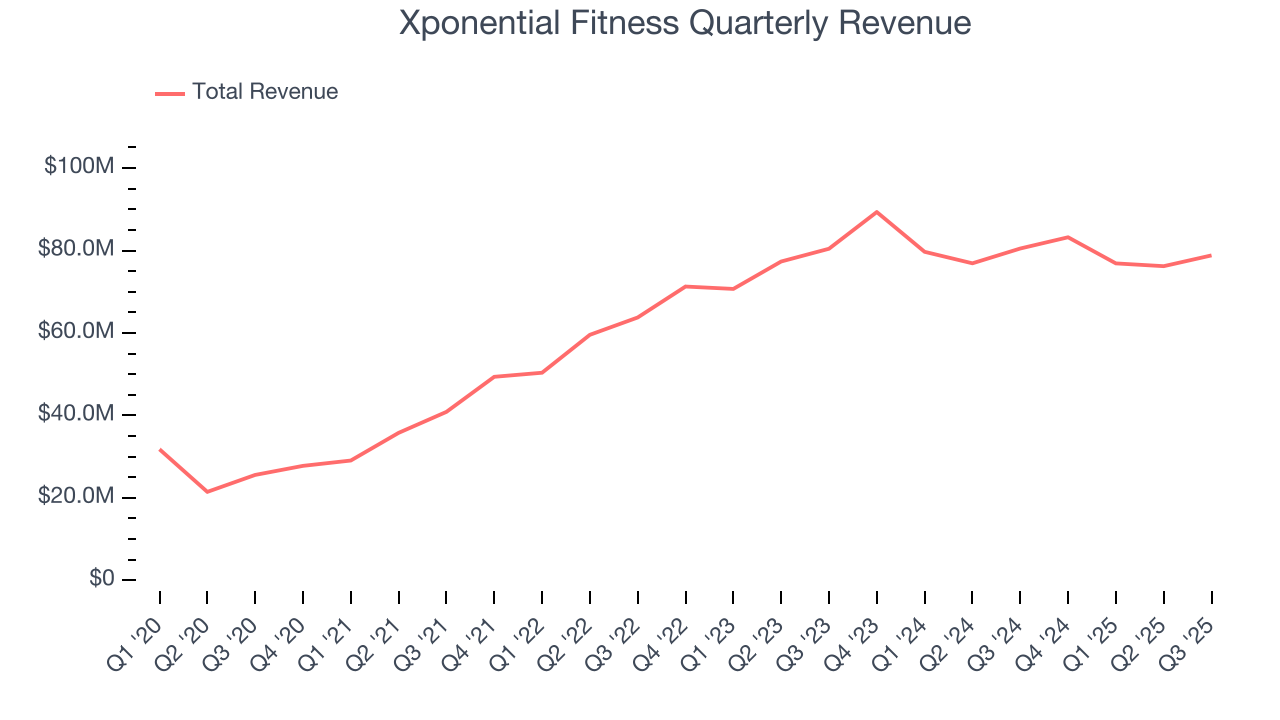
We at StockStory place the most emphasis on long-term growth, but within consumer discretionary, a stretched historical view may miss a company riding a successful new product or trend. Xponential Fitness’s recent performance shows its demand has slowed significantly as its annualized revenue growth of 2.5% over the last two years was well below its five-year trend. Note that COVID hurt Xponential Fitness’s business in 2020 and part of 2021, and it bounced back in a big way thereafter. 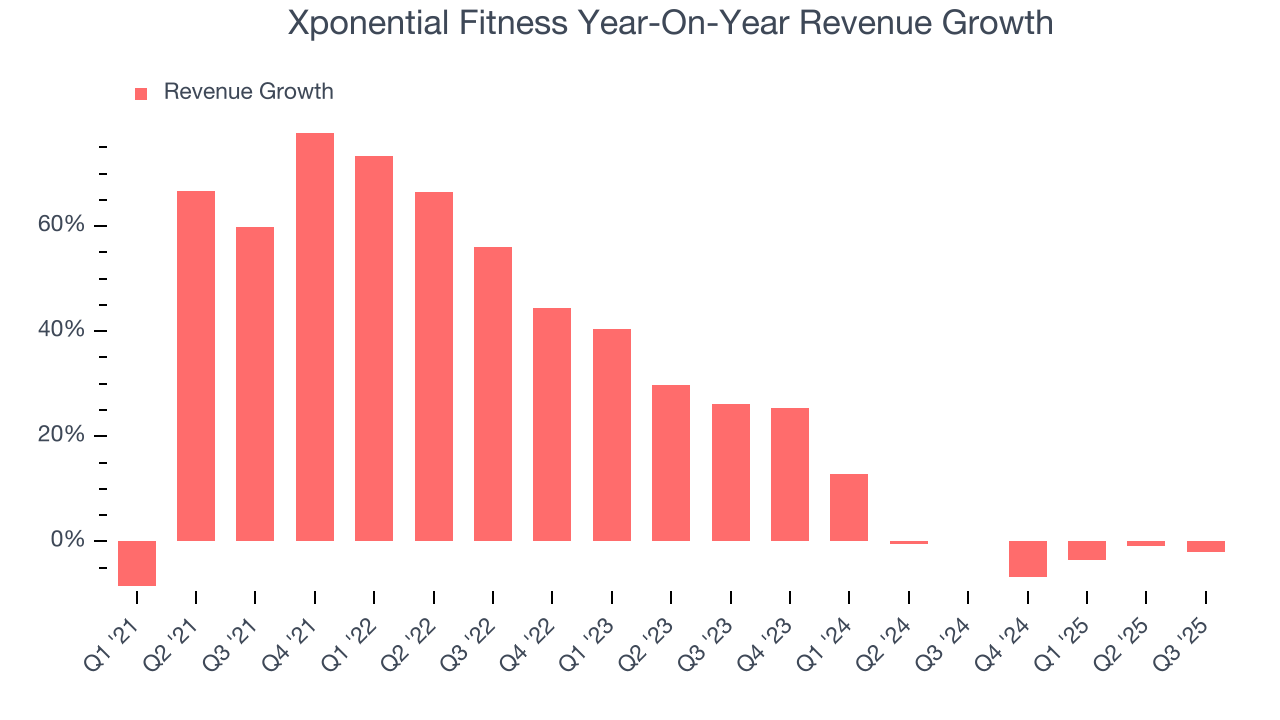
We can better understand the company’s revenue dynamics by analyzing its three most important segments: Franchise, Equipment, and Merchandise, which are 65.8%, 9.5%, and 6.1% of revenue. Over the last two years, Xponential Fitness’s Franchise revenue (royalty fees) averaged 17% year-on-year growth while its Equipment (workout equipment sold to franchisees) and Merchandise (apparel sold to franchisees) revenues averaged declines of 8% and 13.9%. 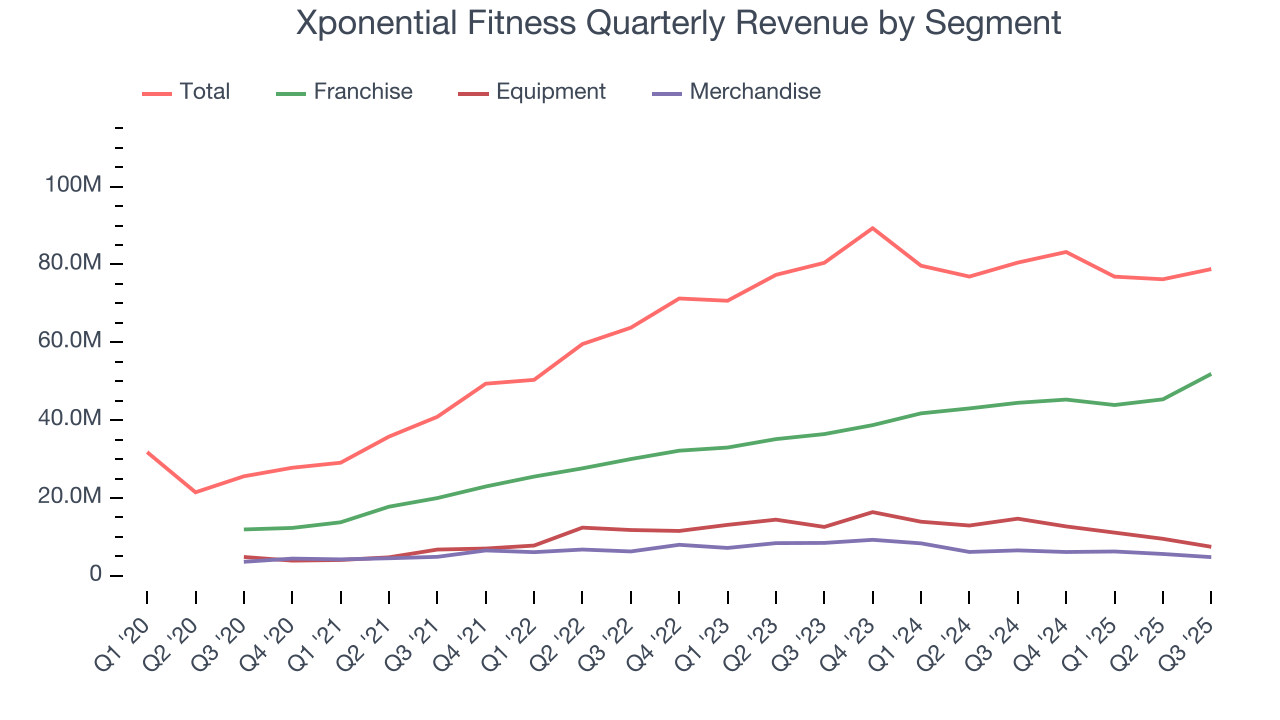
This quarter, Xponential Fitness’s revenue fell by 2.1% year on year to $78.82 million but beat Wall Street’s estimates by 3.9%.
Looking ahead, sell-side analysts expect revenue to decline by 2.1% over the next 12 months, a deceleration versus the last two years. This projection is underwhelming and indicates its products and services will see some demand headwinds.
6. Operating Margin
Xponential Fitness’s operating margin has shrunk over the last 12 months and averaged negative 4% over the last two years. Unprofitable, high-growth companies warrant extra scrutiny, especially if their margins fall because they’re spending loads of money to stay relevant, an unsustainable practice.
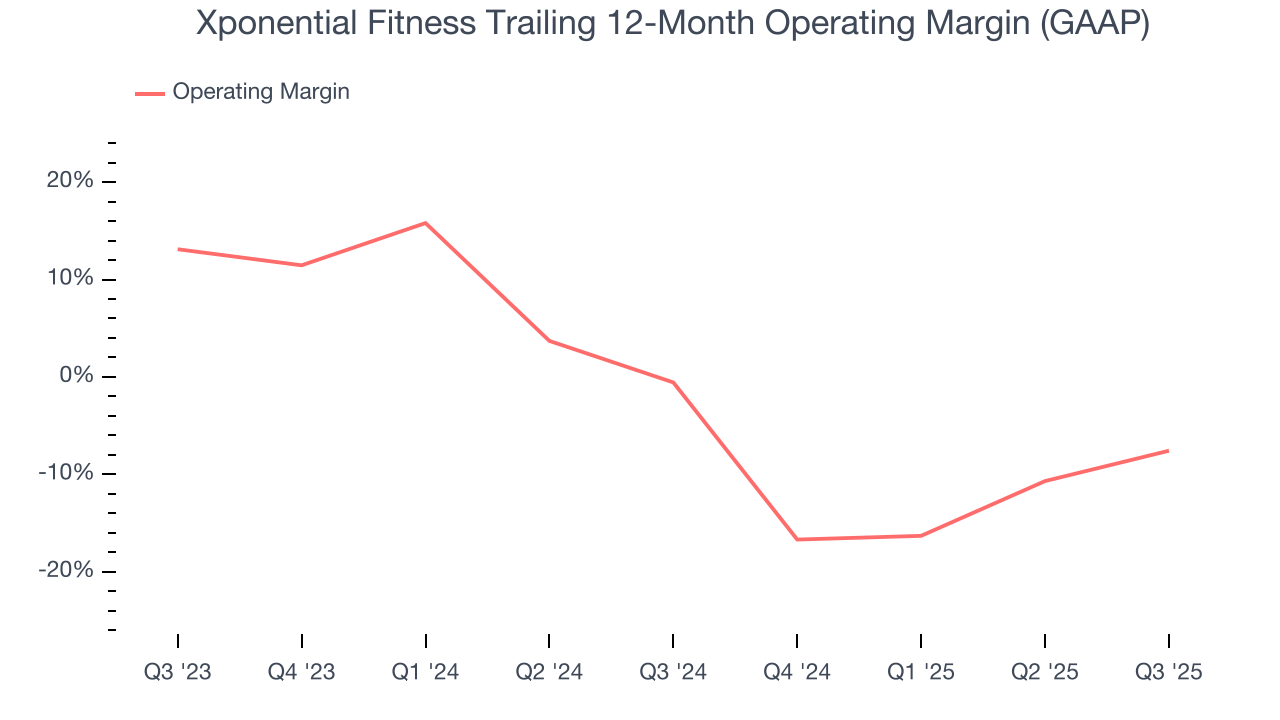
In Q3, Xponential Fitness generated an operating margin profit margin of 4.5%, up 12.5 percentage points year on year. This increase was a welcome development, especially since its revenue fell, showing it was more efficient because it scaled down its expenses.
7. Earnings Per Share
Revenue trends explain a company’s historical growth, but the long-term change in earnings per share (EPS) points to the profitability of that growth – for example, a company could inflate its sales through excessive spending on advertising and promotions.
Xponential Fitness’s full-year EPS flipped from negative to positive over the last four years. This is encouraging and shows it’s at a critical moment in its life.

In Q3, Xponential Fitness reported adjusted EPS of $0.34, up from negative $0.04 in the same quarter last year. This print easily cleared analysts’ estimates, and shareholders should be content with the results. Over the next 12 months, Wall Street expects Xponential Fitness’s full-year EPS of $0.21 to grow 395%.
8. Cash Is King
If you’ve followed StockStory for a while, you know we emphasize free cash flow. Why, you ask? We believe that in the end, cash is king, and you can’t use accounting profits to pay the bills.
Xponential Fitness has shown poor cash profitability over the last two years, giving the company limited opportunities to return capital to shareholders. Its free cash flow margin averaged 2.3%, lousy for a consumer discretionary business.
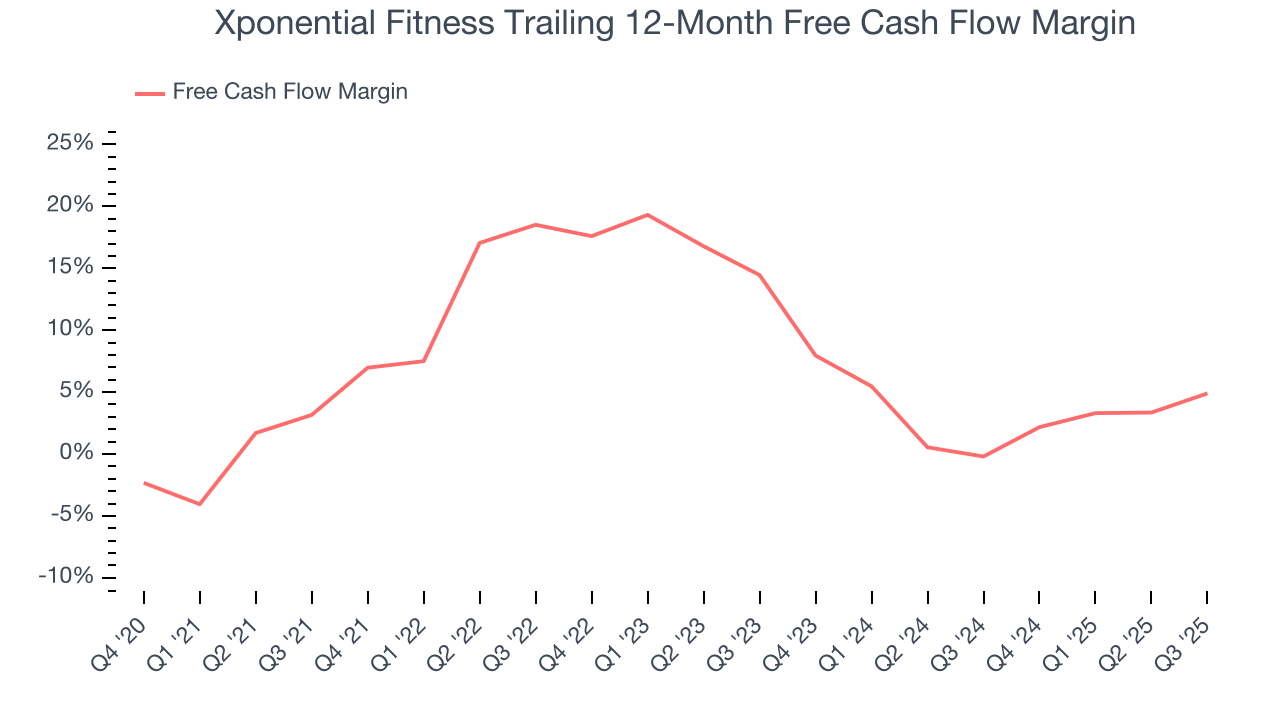
Xponential Fitness’s free cash flow clocked in at $8.22 million in Q3, equivalent to a 10.4% margin. This result was good as its margin was 6.2 percentage points higher than in the same quarter last year, but we wouldn’t read too much into the short term because investment needs can be seasonal, leading to temporary swings. Long-term trends trump fluctuations.
Over the next year, analysts predict Xponential Fitness’s cash conversion will improve. Their consensus estimates imply its free cash flow margin of 4.9% for the last 12 months will increase to 20.6%, giving it more flexibility for investments, share buybacks, and dividends.
9. Return on Invested Capital (ROIC)
EPS and free cash flow tell us whether a company was profitable while growing its revenue. But was it capital-efficient? A company’s ROIC explains this by showing how much operating profit it makes compared to the money it has raised (debt and equity).
Xponential Fitness’s five-year average ROIC was negative 28.1%, meaning management lost money while trying to expand the business. Its returns were among the worst in the consumer discretionary sector.
We like to invest in businesses with high returns, but the trend in a company’s ROIC is what often surprises the market and moves the stock price. Unfortunately, Xponential Fitness’s ROIC has decreased significantly over the last few years. Paired with its already low returns, these declines suggest its profitable growth opportunities are few and far between.
10. Balance Sheet Assessment
Xponential Fitness reported $41.46 million of cash and $375.1 million of debt on its balance sheet in the most recent quarter. As investors in high-quality companies, we primarily focus on two things: 1) that a company’s debt level isn’t too high and 2) that its interest payments are not excessively burdening the business.

With $119.7 million of EBITDA over the last 12 months, we view Xponential Fitness’s 2.8× net-debt-to-EBITDA ratio as safe. We also see its $22.23 million of annual interest expenses as appropriate. The company’s profits give it plenty of breathing room, allowing it to continue investing in growth initiatives.
11. Key Takeaways from Xponential Fitness’s Q3 Results
It was good to see Xponential Fitness beat analysts’ revenue, EPS, and EBITDA expectations this quarter. This outperformance was driven by its Franchise segment, as its Merchandise and Equipment revenue fell short of Wall Street’s estimates. Overall, we think this was still a solid quarter with some key areas of upside. The stock traded up 13.5% to $7.15 immediately after reporting.
12. Is Now The Time To Buy Xponential Fitness?
Updated: December 3, 2025 at 10:12 PM EST
Before making an investment decision, investors should account for Xponential Fitness’s business fundamentals and valuation in addition to what happened in the latest quarter.
Xponential Fitness doesn’t pass our quality test. For starters, its revenue growth was weak over the last five years, and analysts expect its demand to deteriorate over the next 12 months. And while its projected EPS for the next year implies the company’s fundamentals will improve, the downside is its relatively low ROIC suggests management has struggled to find compelling investment opportunities. On top of that, its low free cash flow margins give it little breathing room.
Xponential Fitness’s P/E ratio based on the next 12 months is 10x. While this valuation is optically cheap, the potential downside is huge given its shaky fundamentals. There are better investments elsewhere.
Wall Street analysts have a consensus one-year price target of $10.90 on the company (compared to the current share price of $6.96).
Although the price target is bullish, readers should exercise caution because analysts tend to be overly optimistic. The firms they work for, often big banks, have relationships with companies that extend into fundraising, M&A advisory, and other rewarding business lines. As a result, they typically hesitate to say bad things for fear they will lose out. We at StockStory do not suffer from such conflicts of interest, so we’ll always tell it like it is.








